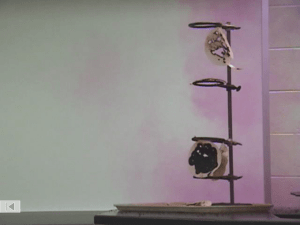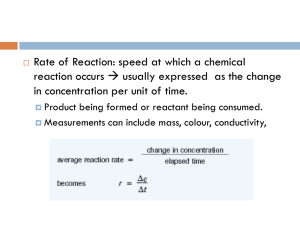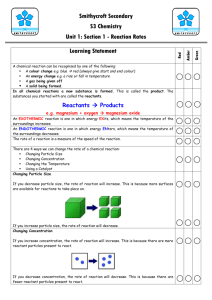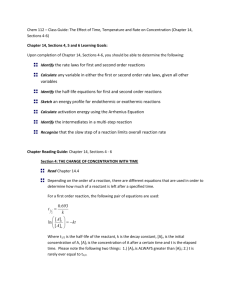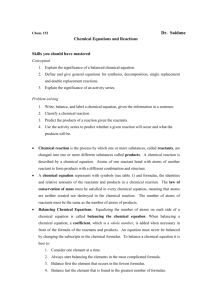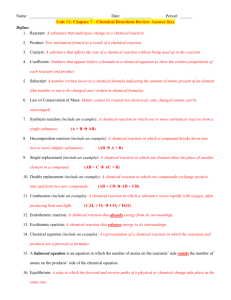Chemistry Answer Key: Chemical Reactions & Fire Safety
advertisement
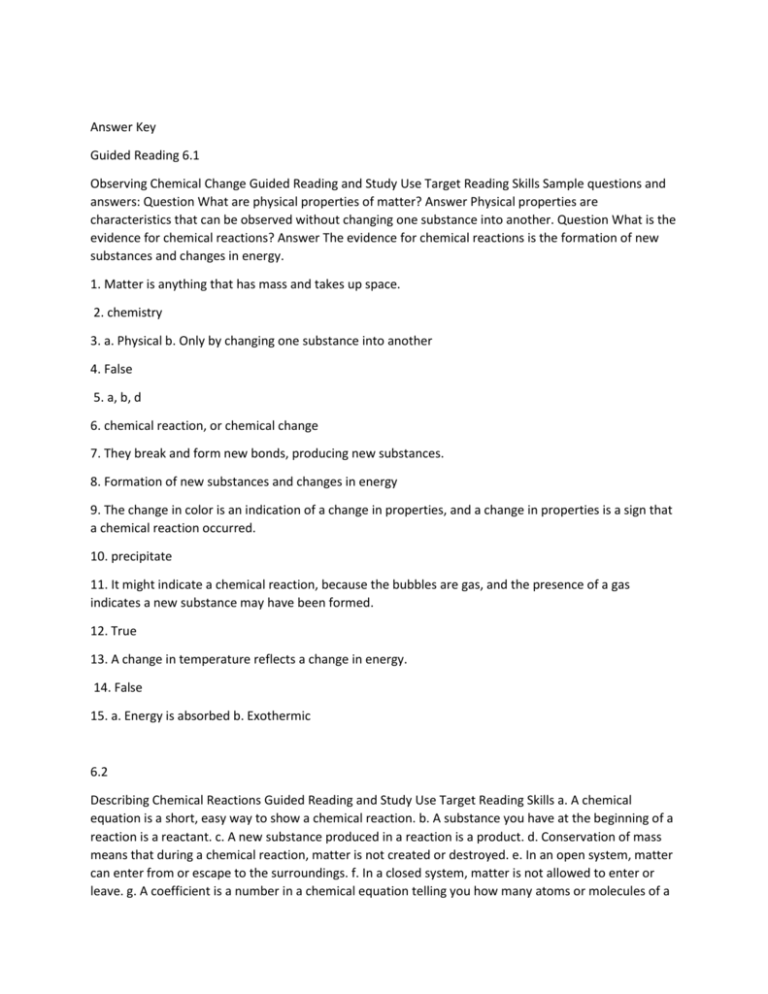
Answer Key Guided Reading 6.1 Observing Chemical Change Guided Reading and Study Use Target Reading Skills Sample questions and answers: Question What are physical properties of matter? Answer Physical properties are characteristics that can be observed without changing one substance into another. Question What is the evidence for chemical reactions? Answer The evidence for chemical reactions is the formation of new substances and changes in energy. 1. Matter is anything that has mass and takes up space. 2. chemistry 3. a. Physical b. Only by changing one substance into another 4. False 5. a, b, d 6. chemical reaction, or chemical change 7. They break and form new bonds, producing new substances. 8. Formation of new substances and changes in energy 9. The change in color is an indication of a change in properties, and a change in properties is a sign that a chemical reaction occurred. 10. precipitate 11. It might indicate a chemical reaction, because the bubbles are gas, and the presence of a gas indicates a new substance may have been formed. 12. True 13. A change in temperature reflects a change in energy. 14. False 15. a. Energy is absorbed b. Exothermic 6.2 Describing Chemical Reactions Guided Reading and Study Use Target Reading Skills a. A chemical equation is a short, easy way to show a chemical reaction. b. A substance you have at the beginning of a reaction is a reactant. c. A new substance produced in a reaction is a product. d. Conservation of mass means that during a chemical reaction, matter is not created or destroyed. e. In an open system, matter can enter from or escape to the surroundings. f. In a closed system, matter is not allowed to enter or leave. g. A coefficient is a number in a chemical equation telling you how many atoms or molecules of a reactant or product take part in the reaction. h. Synthesis means combining two or more elements or compounds to make a more complex substance. i. Decomposition means breaking down compounds into simpler products. j. Replacement is the process in which one element replaces another in a compound or two elements in different compounds trade places. 1. A short, easy way to show a chemical reaction 2. True 3. By its chemical formula, CO2 4. reactants 5. products 6. Yields 7. a. Reactant b. Reactant c. Product 8. b, d 9. True 10. The total mass of the reactants is the same as the total mass of the products. 11. During a chemical reaction, matter is not created or destroyed. 12. Matter can enter from or escape to the surroundings. 13. Sample answer: a sealed plastic bag 14. When it accurately represents the conservation of mass by showing the same number of each type of atom on both sides of the equation 15. There are two atoms of oxygen on each side. 16. d 17. coefficient 18. It tells you how many atoms or molecules of each reactant or product take part in the reaction. 19. There are two oxygen atoms in the reactants, but only one oxygen atom in the product. 20. 2 H2 + O2 → 2 H2O 21. Synthesis, decomposition, and replacement reactions 22. Synthesis 23. a. Synthesis b. Compounds are broken down into simpler products c. Replacement 24. a. Decomposition b. Synthesis c. Replacement 6.3 Controlling Chemical Reactions Guided Reading and Study Use Target Reading Skills a. Increase in surface area b. Increase in temperature c. Increase in concentration d. Use of a catalyst 1. activation energy 2. True 3. The activation energy can be a spark. 4. Exothermic reaction 5. Endothermic reaction 6. For the reaction to start, a tiny amount of activation energy is needed. Once a few molecules react, the rest will quickly follow because the first few reactions provide activation energy for more molecules to react. 7. The energy of the products is greater than the energy of the reactants. 8. Endothermic 9. The peak of the curve 10. Surface area, temperature, concentration, use of a catalyst, or use of an inhibitor 11. Increasing the surface area allows more particles of a substance to react, and this increases the rate of the reaction. 12. Reaction rates are faster at higher temperatures. 13. a, c 14. concentration 15. Increasing the concentration of the reactants supplies more particles to react. 16. True 17. A catalyst is a material that increases the rate of a reaction by lowering the activation energy. 18. False 19. enzyme 20. Many chemical reactions necessary for life happen at temperatures that would kill living things. Enzymes are necessary to allow these reactions to occur at body temperature. 21. An inhibitor is a material used to decrease the rate of a reaction. 22. Most inhibitors work by preventing reactants from coming together. 6.4 Fire and Fire Safety Guided Reading and Study Use Target Reading Skills Sample answers: What You Know 1. A fire needs fuel to burn. 2. A fire needs oxygen to burn 3. All homes should have smoke detectors. What You Learned 1. Fire is the result of a combustion reaction. 2. The most deadly fires start with cigarettes. 3. Baking soda can be used to put out small fires. 1. Combustion is a rapid reaction between oxygen and a substance called a fuel. 2. fuel 3. Fuel, oxygen, and heat 4. a 5. True 6. Water covers the fuel, which keeps the fuel from coming into contact with oxygen. The evaporation of water also uses up heat, which cools the fire. 7. Small heaters, cooking, faulty wiring 8. baking soda 9. a,c,d


